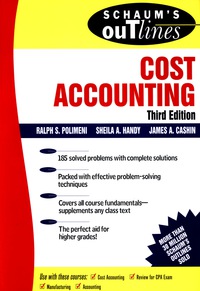Question
Two Departments, Journal Entries with Supporting CalculationsWeighted Average Method Patterson Laboratories, Inc., produces one of its products in two successive departments. All materials are added
Two Departments, Journal Entries with Supporting CalculationsWeighted Average Method
Patterson Laboratories, Inc., produces one of its products in two successive departments. All materials are added at the beginning of the process in Department 1; no materials are used in Department 2. Conversion costs are incurred evenly in both departments. Patterson uses the weighted average method for process costing. January 1, 2019, inventory account balances are as follows:
| Materials inventory | $30,000 |
| Work in processDepartment 1 (3,000 units, 30% complete) | |
| Direct material | 4,560 |
| Conversion costs | 10,640 |
| Work in processDepartment 2 (3,550 units, 40% complete) | 43,439 |
| Finished goods inventory (2,000 units @ $16) | 32,000 |
During January, the following transactions occurred:
-
Purchased material on account, $90,000.
-
Placed $84,000 of material into process in Department 1. This $84,000 represents 24,000 units of
materials.
-
Distributed total payroll costs: $108,116 of direct labor to Department 1, $62,700 of direct labor
to Department 2, and $51,000 of indirect labor to Manufacturing Overhead.
-
Incurred other actual manufacturing overhead costs, $81,000. (Credit Other Accounts.)
-
Applied overhead to the two processing departments: $88,000 to Department 1 and $43,900 to
Department 2.
-
Transferred 25,000 completed units from Department 1 to Department 2. The 2,000 units remaining
in Department 1 were 20% completed with respect to conversion costs.
-
Transferred 26,000 completed units from Department 2 to finished goods inventory. The 2,550
units remaining in Department 2 were 70% completed with respect to conversion costs.
-
Sold 20,000 units on account at $27 per unit. Patterson uses weighted average inventory costing procedures
for the finished goods inventory.
- Part A
- Part B
- Part C
- Part D
b. Prepare a product cost report (with its supporting calculations) for Department 1.
Round average cost per equivalent unit to two decimal places. Use rounded answers for subsequent calculations. Round other answers to the nearest whole number.
| Patterson Laboratories, Inc. Department 1 Flow of Units and Equivalent Units Calculations, January 2019 | ||||||
|---|---|---|---|---|---|---|
| Equivalent Units | ||||||
| % Work Done | Direct Materials | % Work Done | Conversion Costs | |||
| Complete/Transferred | Answer
| Answer
| Answer
| Answer
| Answer
| |
| Ending Inventory | Answer
| Answer
| Answer
| Answer
| Answer
| |
| Total | Answer
| Answer
| Answer
| |||
| Product Cost Report | ||||||
|---|---|---|---|---|---|---|
| Direct Materials | Conversion Costs | |||||
| Beginning Inventory | Answer
| Answer
| Answer
| |||
| Current | Answer
| Answer
| Answer
| |||
| Total Costs to Account For | Answer
| Answer
| Answer
| |||
| Total Equivalent Units | Answer
| Answer
| ||||
| Average cost / Equivalent unit (round 2 decimal places) | Answer
| Answer
| ||||
| Complete / Transferred: | ||||||
| Direct Materials | Answer
| |||||
| Conversion costs | Answer
| |||||
| Cost of Goods Manufactured | Answer
| |||||
| Ending Inventory: | ||||||
| Direct Materials | Answer
| |||||
| Conversion costs | Answer
| |||||
| Cost of Ending Inventory | Answer
| |||||
| Total Costs Allocated | Answer
| |||||
Determine the balances remaining in the Materials Inventory account, in each work in process account, and in the Finished Goods Inventory account.
Step by Step Solution
There are 3 Steps involved in it
Step: 1

Get Instant Access to Expert-Tailored Solutions
See step-by-step solutions with expert insights and AI powered tools for academic success
Step: 2

Step: 3

Ace Your Homework with AI
Get the answers you need in no time with our AI-driven, step-by-step assistance
Get Started


